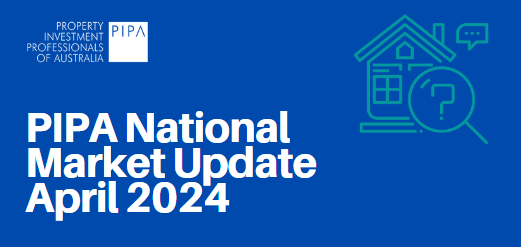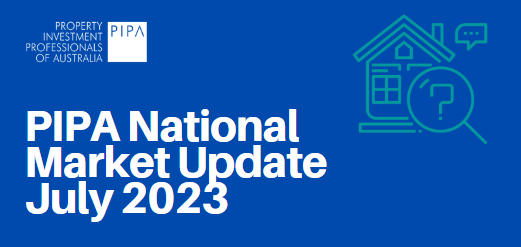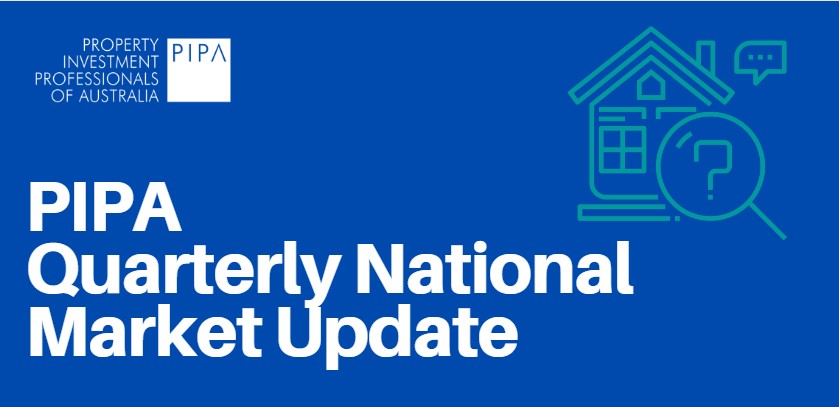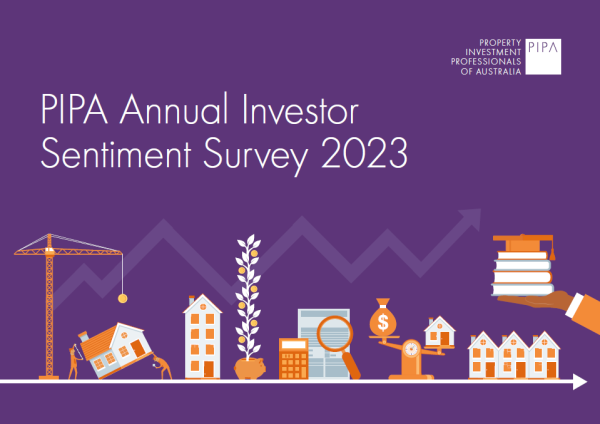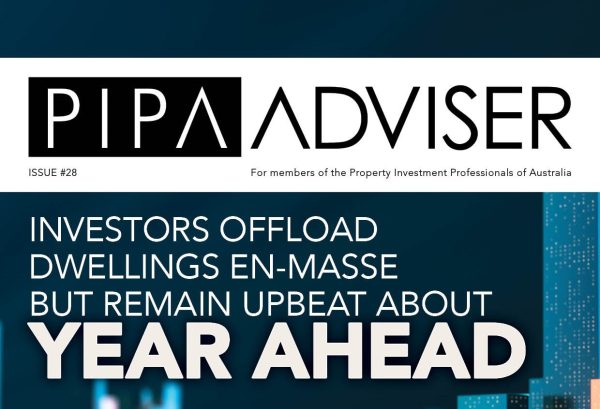PIPA National Market Update – October 2023
Oct 2023Karen Millers
Categories
Location ReportsMedia releasesNational market updatesPersonal advisersPIPA AdviserPIPA Annual Investor Sentiment SurveysPIPA Member ProfilesPIPA video updatesPIPA webinarsPodcastsProperty advisersProperty newsLatest Articles
Location Report – City of Geraldton
Which property cycle are we in?
Rent rises ease but crisis’ link to population density found to be tenuous
Jordan van den Berg: The ‘Robin Hood’ TikToker taking on Australian landlords
Victorian property investors face yet another new property tax as council tests levy
As we head into the final few months of this calendar year, property markets have rebounded significantly from the start of the year, but investor activity has fallen significantly since interest rates started rising, according to the latest PIPA National Market Update.
This report pulls together insights and analysis from eight market experts and PIPA members from the latest edition of the PIPA Adviser e-magazine’s national market update.
PIPA Chair Nicola McDougall said record low vacancy rates appear to be entrenched given investor purchases have not only fallen significantly over the past 18 months, but many thousands are selling off their assets, too.
According to the latest ABS Lending Indicators, the number of new investor loan commitments have fallen more than 27 per cent since interest rates started rising in May last year.
“It’s clear that the normal flow of investment activity – both inbound and outbound – have been off-kilter for some time, so, until that changes, vacancy rates will remain at record lows and rents will climb ever higher,” she said.
“While governments talk about offering incentives to the big end of town for such supply strategies as build-to-rent, not a red cent has been offered to private investors who supply more than four in every five rental properties in this nation.”
Ms McDougall said property prices in most locations had posted solid growth over the past two quarters in particular given stronger market metrics.
“Of course, the low supply of listings was part of the reason why, as well as strong rental market conditions and record overseas migration,” Ms McDougall said.
“Indeed, a number of reliable forecasters are predicting even stronger market conditions next year – although it appears that listings have started to increase over recent times.”
NEW SOUTH WALES
Dr. Kevin Hoang, Investment Property Research Manager, Senior Economist, inSynergy Advisory
“The New South Wales housing market is the largest component of the Australian housing market with the total housing value of $4 trillion or 40 per cent of total national housing value (ABS, June 2023).
“The New South Wales market is characterized by large short-term volatility and is known for being the most expensive city to purchase and rent in Australia and in the world. Currently, ABS data shows that the median dwelling price in NSW is $1,167,000, approximately 30 per cent higher than in Victoria, 23 per cent higher than in the ACT, 50 per cent higher than in Queensland, and 123 per cent higher than in Northern Territory.
“From a long-term perspective spanning from 1990 to 2023, the median house price in NSW has increased by 8.3 times, making it the second-best performing city after Hobart (which saw a nine-fold increase due to a lower starting price).
“The strength of the NSW housing market is underpinned by high population growth, a diverse and dynamic economy, large infrastructure investments, and its role as Australia’s gateway for overseas investment and international trade.
“NSW’s property market has faced challenges related to affordability. High property prices relative to income levels have made it difficult for many first-time homebuyers to enter the market.
“Real mortgage repayment as a percentage of household income in Sydney currently tops the country, currently sitting at 38 per cent. The situation is not likely to improve soon in the context of chronic supply constraints and predicted high population growth in the foreseeable future.
“Looking ahead, most housing activities will be concentrated in Greater Sydney due to job opportunities and business prospects. Affordability will continue to be the primary driver of housing price growth in Sydney.
“As a result, the Northwest and Southwest regions, along with properties priced under $1.5 million, are expected to lead in terms of growth prospects. Units in convenient areas close to amenities and major public transport corridors have been in high demand among singles and small families, which will see a boost in both rental and price growth.
“The NSW housing market is anticipated to rebound swiftly from the recent downturn and will remain an influential component of the Australian housing market landscape.
“Factors such as continued population growth, economic stability, and infrastructure development are likely to contribute to long-term growth, albeit at a more moderate pace compared to previous years and, in comparison, to other more affordable states and territories.”
VICTORIA
Terry Ryder, Director, Hotspotting
“Melbourne has taken over as the biggest city in Australia for the first time in over 100 years, surpassing Sydney, as declared by the Australian Bureau of Statistics in 2021.
“This was due to the inclusion of the district of Melton into Melbourne’s catchment, adding a population of nearly19,000 more people.
“Despite facing challenges during the pandemic, Melbourn has shown resilience and stability in its property market.
“However, the rising interest rates and shifting lifestyle demands have caused investors and homeowners to look at options such as units and townhouses instead of standalone houses.
“The City of Melbourne, with its high-density dwellings making up 86 per cent of homes, has become an attractive destination for both living and working.
“Its strong economy, with major businesses, universities, hospitals, and government services, has been further bolstered by ongoing infrastructure projects such as the North East Rail Link and the proposed Suburban Rail Loop.
“These developments are expected to bring in significant investments and create thousands of jobs, ensuring continued growth and stability in Melbourne’s property market.
“Most suburbs in the City of Hume have median house prices between $560,000 to $760,000, with Meadow Heights the cheapest at $560,000.
“This compares well to the Greater Melbourne median house price of $920,000.
“Annual sales activity has remained strong, with most suburbs experiencing 100 or more house transactions.
“Craigieburn turnovers were the highest in the LGA, with 740 sales across the year for a median price of $645,000.
“These notable figures are thanks in large part to Craigieburn’s ample vacant land, Hume Highway location, and Metro train network terminus. There are also significant jobs nodes up in the north of the Greater Melbourne area.
“City of Hume house investors can expect returns of 3.5 per cent to four per cent, with both houses and units in Craigieburn presenting a good example of such returns.
“Outside of Melbourne, in Geelong, Armstrong Creek, Charlemont and the suburb of Geelong are all rising markets.
“Both Armstrong Creek and Geelong were included on our National Top 75 Supercharged Suburbs list for their strong growth patterns.
“Data shows that Greater Geelong is a steady, highly consistent market that continues to see solid demand in 2023.
“Many Geelong suburbs have capital growth rates averaging around 10 per cent per year for the past decade – while Barwon Heads, Indented Head and Queenscliff averaged 13 to 14 per cent per year.”
QUEENSLAND
Colin Lee, Founder and CEO, Inspire Realty
“There is a significant rise in interest for property ownership and investments in the state of Queensland.
“In an intriguing twist, property prices have soared by an impressive 9.1 per cent since January, all while grappling with the backdrop of rising inflation and interest rates.
“Traditionally, spring marks a bustling season in the real estate world, and now, as we find ourselves amidst it, it’s an apt moment to contemplate the potential trajectory of Brisbane’s real estate prices.
“From our vantage point, the appears resolutely upward, with several contributing factors that paint an optimistic picture.
“October presents Brisbane on the verge of breaking records, with property values just 0.6 percent shy of their previous peak, according to CoreLogic data.
“The housing market in Brisbane shines, outpacing the unit market, and nearly half of this year’s growth transpired in the last three months. This suggests that a pause in the interest rate cycle might have amplified buyer confidence.
“With the Reserve Bank of Australia maintaining the cash rate at 4.1 per cent for the fourth consecutive month in October, buyers are seemingly more willing to consider the cost of borrowing, possibly sensing that interest rates are nearing their peak.
“CoreLogic’s Home Value Index (HVI) offers an encouraging glimpse into the Australian property market, forecasting record-high prices by November.
“Over the past eight months, prices have steadily ascended. During the September quarter, Brisbane experienced a remarkable property price growth rate of 3.9 per cent. With the HVI indicating a continuation of this trajectory, there’s little to suggest any slowdown in house prices.
“Whether you’re a tenant or a homeowner, it’s likely that the ongoing rental crisis in Australia has not escaped your attention.
“In Brisbane, rental vacancy rates have plummeted to historic lows, propelling weekly rent levels to new heights. Queensland leads the nation with an 83.69 per cent Rental Pain Index, vividly illustrating the challenges tenants face.
“This predicament is steering people away from renting and toward the pursuit of property ownership, further intensifying the pressure on the housing market. The rental market in virtually all areas of the city remains remarkably tight, with SQM Research data indicating a drop in vacancy rates from one per cent in July to 0.9 per cent in August.
“As we approach 2024, buyers should prepare for intense competition and swift decision-making, as sought-after properties are once again selling rapidly. For buyers, this may be an opportune time to buy and invest in property and secure something before the end of the year and the surge in 2024.
“While housing affordability has become more challenging in Queensland over the last two years, it remains relatively attractive compared to other east coast capital cities, continuing to drive demand for housing in and around Brisbane.”
SOUTH AUSTRALIA
Jess Elam, Buyer Advocate, Jess Elam Property
“South Australia’s housing market in 2023 has remained resilient, standing out with its strong performance. This growth trend has persisted even as other states started to cool down in 2022.
“This remarkable performance can be attributed to a combination of factors: a scarcity of available properties and consistently high demand. As a result, buyers have remained fiercely competitive, driving property prices upward.
“Notably, specific regions within South Australia have witnessed significant growth.
“Suburbs along the southeast coast have experienced substantial appreciation over the past two years, and this momentum has carried into 2023. These areas, located 20 to 40 kilometres from Adelaide, offer easy access to the city centre, proximity to stunning beaches, renowned wineries in McLaren Vale, family-friendly neighbourhoods, and an array of lifestyle amenities.
“This combination of factors makes them attractive to both investors, who benefit from low vacancy rates and high rental yields, and families seeking a lifestyle change, including interstate homebuyers choosing South Australia.
“The Southern Expressway, undergoing continuous improvements, enhances accessibility to the CBD, making the southern suburbs even more appealing.
“In terms of opportunities for homebuyers and investors in South Australia, there are numerous options available in specific suburbs.
“With a budget starting at $600,000, investors can find properties with promising growth prospects and yields. However, it’s crucial for investors to be well-informed about the Adelaide market to make the most of these opportunities.
“Adelaide stands out among other eastern seaboard state capitals for offering attractive capital growth opportunities at lower price points and reasonable rental returns compared to Melbourne and Sydney.
“Looking at the overall outlook for South Australia’s housing market, it appears robust.
“The state has consistently demonstrated growth, supported by steady population growth, ongoing infrastructure upgrades, and its appealing lifestyle. Additionally, industries like Health, Technology, Space, and Defence continue to drive up property prices, population growth, and investor interest.
“Furthermore, South Australia is expected to see an influx of first-time homebuyers due to the State government’s initiatives, such as the abolishment of stamp duty for homes up to $650,000 and an increased cap on the First Home Buyers Grant (FHBG) to the same purchase price threshold.
“Lastly, South Australia is experiencing increased interstate and overseas migration, with expats returning, interstate homebuyers moving in, and international students being welcomed back. This influx of new residents adds to the positive momentum in the housing market.”
TASMANIA
Samantha Spilsbury, Director, Buyer’s Agents Tasmania
“Spring has sprung in Tasmania, and with it comes the promise of warmer weather and vibrant blossoms, making it the favoured time of year for most Tasmanians. As we step into spring, the real estate market is blossoming, too, offering an abundance of options for buyers.
“Over the past month, we’ve witnessed a surge in buyer enquiries, a promising indicator that confidence is returning to the property market. Tasmania’s moving annual median sale price for houses has seen a commendable 2.1 per cent uptick since this time last year, now standing at an impressive $610,323. Furthermore, house sales have surged by seven per cent compared to the same period last year, totalling 504 transactions.
“For those eyeing land, there’s good news as well. The moving annual median sale price for land has risen by 1.5 per cent compared to last year, now standing at $264,042. Land sales have followed suit, showing a substantial 6.7 per cent increase with 95 sales over the same period.
“In the rental market, the vacancy rate for the state decreased marginally by 0.1 per cent to settle at 1.9 per cent in August 2023.
“Rental prices have also seen some fluctuations. In Hobart, the median rental price per week for two-bedroom units increased by $5 to $445, while three-bedroom houses saw a $20 decrease, now averaging $510 per week.
“In Launceston, two-bedroom unit rentals decreased by $50 to $350, and three-bedroom house rentals dipped by $10 to $450. Meanwhile, in the North-West, rentals for units increased by $40 to $340 per week, while houses decreased by $35 to $380 per week.
“Looking ahead to February 2024, there’s excitement in the air as the new Spirits of Tasmania boats are set to arrive. These vessels will see their overall length increase from 194.33 meters to an impressive 212 meters, accommodating a surge in passenger capacity from 1,400 to 1,800.
“With an additional 79 cabins being added, taking the total to 301, and a nearly 60 per cent increase in lane meters for passenger and freight vehicles on board, the economic impact is anticipated to be substantial.
“The influx of travellers via these larger ferries is expected to have a transformative effect on Tasmania’s economy, bringing with it an upswing in tourism and a promising ripple effect throughout the state.
“Tasmania is on the cusp of an exciting period of growth and opportunity, as the allure of its springtime beauty and thriving real estate market intertwine with the arrival of these new vessels, promising a brighter future for the island state.”
ACT
Claire Corby, Buyers’ Agent, Capital Buyers Agency
“The ACT market continues its conservative path that has dominated 2023.
“Rents continue to fall in Canberra, contrary to the conversation around the rest of the country. What was previously the most expensive city for rentals, has now fallen behind Sydney with a -3.0 per cent annual decline (CoreLogic), much of that decrease occurring since April this year.
“Premium properties have been more heavily discounted with homes above $1,000pw requiring significant price adjustments to secure a tenant.
“Unit rental price growth is the quiet surprise, bucking the trend with a monthly 0.4 per cent increase to $569pw in September (CoreLogic). While it’s too soon to tell if this is the beginning of an upward lift or simply a blip on the radar, it could be an early sign of growth – like a tulip at Floriade.
“Auction clearance rates have also fallen throughout 2023 to a consistent 50 per cent to 55 per cent strike rate on auction day throughout early Spring (CoreLogic). Vendors who are willing to lower their price expectations from the heady days of last year are the ones popping the champagne, with median house prices moving at glacial pace to $930,000 (Allhomes).
“Not all pockets are moving at the same pace though; the premium suburbs of the Inner South have risen to a median $1,977,500 (Allhomes).
“Short supply is the catch cry across the ACT market from buyers and agents alike. Typically, around 5,000 to 6,000 houses are transacted each year; in 2023 we’re only at 3,500 in October (Allhomes).
“Units are down from 8,000 to 9,000 in 2021 and 2022 to a mere 5,000 in 2023 YTD. Sales volumes are down, days on market are up, and buyers aren’t keen to take on a large mortgage – especially if the purchase requires a high degree of renovation.
“Rates have risen with unimproved land values here skyrocketing after COVID19, and buyers for bigger blocks are budget conscious of these increased holding costs.
“The recent announcement by the ACT Government to change the Territory Plan will soon allow even the lowest density blocks – zoned RZ1 – to construct a second dwelling on the site, subject to the obligatory red tape that Canberrans know all too well.
“Boiled down, on blocks zoned RZ1 over 800m2 it may be permissible to build a second residence no greater than 120m2 in size. This change is expected to be enacted from late November 2023.
“Time will tell if the Canberra market continues to simmer along, or if the ongoing shortage will impact prices as we approach the finish line of 2023. It’s expected that quality, renovated homes will continue to elicit strong demand and consistent capital growth.”
WESTERN AUSTRALIA
Corey Jones, Managing Director, Motivate Property Group
“Driven by the fastest population growth in the country (2.8 per cent) as per the ABS, the WA property market has performed considerably well, despite all the negative outlook and opinions of the so-called “economic experts” from the finance and banking industry.
“In the past 12-months, the asking prices of houses, units, as well as rents have all had double-digit growth according to SQM Research, as well as being the most affordable property market in the country, where many areas can still be entered under $600,000.
“WA recently broke a new state record within the established property market, averaging 10-days to sell a listing, with many local councils struggling to keep up with the demand from overseas and interstate migration.
“The rental market is as tight as it has been in decades, with a vacancy rate of 0.4 per cent as per SQM Research, which in turn has pushed the median rental price at a new high of $575 per week.
“On the back of WA’s COVID19 hard border closure, the uptick in skilled worker demand in the WA mining sector, as well as the unprecedented demand during the HomeBuilder grant stimulus, the construction market is still being held down by a lack of skilled workers across the board.
“The WA population has grown by almost 80,000 people, while simultaneously struggling to build 20,000 homes to keep up with this demand.
“After speaking with several selling agents, builders and land developers over the past few weeks, it’s becoming apparent that land access will be the next hurdle that WA will face to help keep the market buoyant.
“From a land perspective, WA has more than any state in the world, however, we’re struggling with the manpower to physically develop the land and have it ready to build on for the current levels of demand.
“Similarly to what Queensland felt during the height of COVID19, there is a risk that WA may soon run out of titled land, and the only remaining options may be untitled stock with titles pending more than six months away.
“As we head towards the final quarter for 2023, this is a perfect storm of signs that show the market is nowhere near slowing down.”
NORTHERN TERRITORY
Richard Sheppard, Director & Chief Property Wealth Planner, inSynergy Advisory
“Darwin has returned to our radar as a market to watch in 2023. Looking back over the past three decades, Darwin was historically a high-performing city, experiencing growth and prices on par with major capitals like Brisbane and Melbourne in 1996, 2008, and 2013, largely driven by mining booms during those times.
“Currently, Darwin boasts a median house price of $600,000, which is 40 per cent of Sydney’s median price. Additionally, the city has an extensive pipeline of substantial infrastructure projects valued at tens of billions of dollars set to unfold over the next decade.
“Notably, rental yields are impressive, with houses at 6.9 per cent and units at 5.2 per cent, and there’s a consistent low vacancy rate of around one per cent. These factors collectively create a compelling potential for growth in the city.
“Darwin’s strategic advantages, such as the Australia Asia Power Link, increased defence funding, and mining investments, position it as one of the most promising markets for the next 10 to 15 years.
“These ambitious initiatives are set to drive significant economic activity, resulting in substantial job opportunities, wage growth, and a notable increase in the population. “Furthermore, the city’s property prices remain relatively affordable, making it particularly attractive for investors looking for a decade of strong growth.
This exceptional influx of economic activity, approaching a staggering $100 billion, represents the largest investment in Australia’s history when viewed on a per capita basis.
“To put it into perspective, the approximately $23 billion invested in Brisbane for the Olympics pales in comparison, with a nearly five-fold difference. Even if only half of the Power Link project expenditure is directed to Darwin, the per capita investment still stands at close to 40 times that of Brisbane, which is an unprecedented catalyst for substantial upward pressure on property values and yields. This surge is occurring in an already undersupplied market with record-low vacancies.
“When we examine investment prospects in Darwin’s inner and city fringe suburbs, it becomes evident that units and townhouses with options for short-term or corporate leasing hold substantial promise.
“With the expected influx of white-collar workers needed to manage the new projects, these properties are poised to yield significant benefits.
“However, it’s essential to acknowledge that while Darwin presents promising investment opportunities, like any housing market, it carries certain risks. These include its relatively small market size, sluggish population growth in recent years, and uncertainties surrounding the implementation of infrastructure projects.
“Nonetheless, considering the current market conditions and the scale of infrastructure investments, Darwin remains an appealing market worthy of exploration.”
ENDS
Bricks & Mortar Media | media@bricksandmortarmedia.com.au
